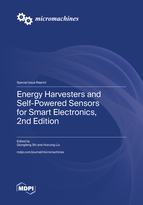Energy Harvesters and Self-Powered Sensors for Smart Electronics, 2nd Edition
A special issue of Micromachines (ISSN 2072-666X). This special issue belongs to the section "A:Physics".
Deadline for manuscript submissions: closed (31 August 2023) | Viewed by 17503
Special Issue Editors
Interests: flexible electronics; energy harvesting; self-powered sensing; human–machine interfaces; MEMS; intelligent systems
Special Issues, Collections and Topics in MDPI journals
Interests: sensors; energy harvesting; piezoelectricity; MEMS
Special Issues, Collections and Topics in MDPI journals
Special Issue Information
Dear Colleagues,
In recent years, we have witnessed the revolutionary innovation and flourishing development of the Internet of Things (IoT), which will increase even more with the gradual rollout of the fifth generation (5G) wireless network across the world. Enabled by the ultrahigh-speed data communication capability of 5G, various IoT systems can be envisioned by linking numerous interrelated electronic devices together in an integrated and interconnected network, such as smart factory, unmanned shop, smart home, or wearable body network. Within these complicated and widely distributed systems, energy supply in the IoT era is gradually migrating from the centralized and ordered supply mode towards mobile and in situ supply. Compared to current battery technology, energy harvesting technologies that scavenge available energies from the ambient surroundings show great merits as an energy supply, e.g., extended and unlimited lifetime, high portability, flexible/stretchable compatibility, and the ability to develop sustainability. Recently, different energy harvesting technologies have undergone significant innovation, providing key functionalities in diversified systems such as energy harvesters and self-powered sensors. Accordingly, this Special Issue seeks to showcase research papers and review articles that are focused on advanced developments for the design, fabrication, integration, and application of energy harvesting technologies, with particular interests in energy harvesters, nanogenerators, self-powered sensors and systems.
Dr. Qiongfeng Shi
Prof. Dr. Huicong Liu
Guest Editors
Manuscript Submission Information
Manuscripts should be submitted online at www.mdpi.com by registering and logging in to this website. Once you are registered, click here to go to the submission form. Manuscripts can be submitted until the deadline. All submissions that pass pre-check are peer-reviewed. Accepted papers will be published continuously in the journal (as soon as accepted) and will be listed together on the special issue website. Research articles, review articles as well as short communications are invited. For planned papers, a title and short abstract (about 100 words) can be sent to the Editorial Office for announcement on this website.
Submitted manuscripts should not have been published previously, nor be under consideration for publication elsewhere (except conference proceedings papers). All manuscripts are thoroughly refereed through a single-blind peer-review process. A guide for authors and other relevant information for submission of manuscripts is available on the Instructions for Authors page. Micromachines is an international peer-reviewed open access monthly journal published by MDPI.
Please visit the Instructions for Authors page before submitting a manuscript. The Article Processing Charge (APC) for publication in this open access journal is 2600 CHF (Swiss Francs). Submitted papers should be well formatted and use good English. Authors may use MDPI's English editing service prior to publication or during author revisions.
Keywords
- energy harvesters
- nanogenerators
- self-powered sensors
- smart electronics
- internet of things








